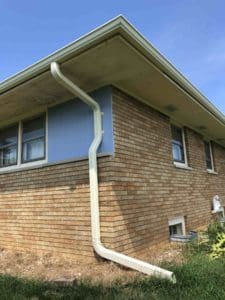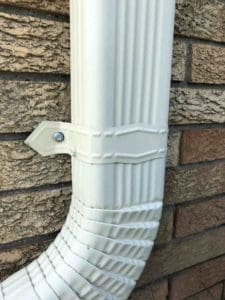Downspouts are critically important if you want a good water management system and unfortunately are the most overlooked by homeowners who are convinced that they’ve already done their due diligence. There are many differences and homeowners that stop at only one or two, make decisions they end up regretting.
Here’s a short list of differences that homeowners find in the Metro Milwaukee market:
Size
Most traditional downspouts are 2″x 3″. If you have good protection from leaves, this size may be fine. If not, a 3″ x 4″ will allow leaves to flow through.
Guage
The most overlooked thing about a gutters system is the thickness of the metal for the downspouts. Most consumers have access to the big box stores which often use .016. Most contractors have access to .019. Your better contractors will use .024. Now for the consumer protection element of this article — professional sales companies will just tell you about the gauge of the gutters which is .032 in most cases. They will omit the gauge of the downspouts, leaving you to believe it is also .032 which would be twice as thick as the downspouts they may actually be putting on your house.
Strap Style
There are 3 types of strapping methods. One uses a bracket that is screwed or nailed through the back of the house and forms a “U” shape. The sides of the “U” are then screwed into the sides of the downspout. “Scrap” straps are a simple flat gutter coil stock used when the company wants to shave a few dollars off of their material job, or if the decorative straps are not practical for the style of the home or the mortar joint location. Optimally, the job would have decorative straps which are made for the job, which are secured over the seams and on both sides.
Strap Location
Gutter straps, secured in two places, should be over the seam where the downspout meets the elbow of a downspout assembly. Not only is it a clean look, but it gives strength and security to the entire system.
Downspout Location
Ask yourself if the new downspout will get some sun during cold days. Will those ice plugs which always happen in the elbows, open up to allow the water to flow? Or, will the downspout always be in the shadow? Are the downspouts being placed in such an area that they will discharge on hardscapes like driveways, sidewalks, or patios? If so, they ice up and can be a slipping hazard. Is there a better place to discharge a downspout and if so, will they provide a positive pitch away from the house?
Securing
How strong will the downspout be if the bottom gets bumped by pets, kids, or lawnmowers? Is it secured by simply one screw through the back, or did the installing company use two screws? Were the screws long enough to get into the house proper? Or were they just 1/4″ which barely made it through the skin on the siding?
Screw Type
Optimally an aluminum strap would be secured with a galvanized steel screw with a rubber washer. Why a rubber washer? Because when dis-similar metals come in contact, a process called galvanic corrosion occurs, leading to the breakdown of the metals. The rubber washer keeps them apart just enough so this doesn’t become a problem.
As you can see, gutters are not “just gutters”. The smart homeowner will look for a water management system that will solve problems. Sometimes you have to look past the nice smiling salesman who rang your doorbell and look for someone who specializes in solutions and will assess your project holistically. In the end, good building sciences will provide you with a solid system that will work for decades to come.



